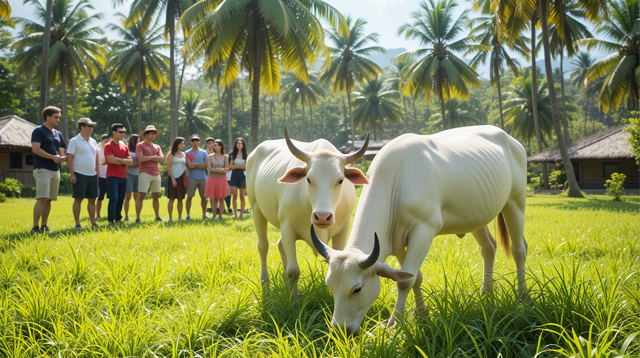TRAVELING to Bali isn’t just about the beaches. Come to Taro Village, Gianyar, and meet the sacred White Ox! Explore the pristine nature and interact with this rare animal. Experience the peace and unique culture that blend with every step. An unforgettable spiritual experience awaits you.
—-
Taro Tourism Village, precisely located in Tegallalang Subdistrict, holds a heritage that is not only culturally significant but also attractive from a tourism perspective. The white ox in this village is now a unique attraction, perhaps unmatched in Bali.
Not because of its beauty, but because of its status, considered sacred and rare in Balinese tradition. The conservation of the white ox in Taro Village has developed into a tourist attraction that attracts both domestic and international tourists with a special interest in Bali’s history, culture, and nature.
Origins of the White Ox in Taro Village
The White Ox in Taro Village is highly made sacred by the local population, and its existence is closely linked to the arrival of Rsi Markandeya in the 7th century from Mount Raung, East Java. This sacred animal is believed to have been brought by him from India as a complement to the Yadnya ceremony. For this reason, the white ox is considered sacred by the local community and must be present at major ceremonies.
According to records from the Taro Tourism Village (2019), the Taro White Ox population, managed on approximately 3 hectares of forest land, is a historical heritage and now numbers approximately 56.
According to Hindu tradition, this white ox is a symbol of the vehicle or vehicle of the Lord Shiva. Therefore, this white ox is believed to bring good luck and is a symbol of purity. Its presence in the Taro Tourism Village has long been preserved due to its strong connection to Hinduism and various religious rituals.
Furthermore, as a sacred animal, this white ox is considered to belong to the gods and protects their lives. Therefore, it is highly revered, and the community calls it “lembu duwe” (property of the gods). When needed, the community uses its milk, dung, and urine.
The Taro white ox has distinct physical characteristics compared to most cattle. Their pure white skin and soft fur give them an exotic appearance and exude an aura of purity.
Furthermore, these white cattle also hold high spiritual value for the Balinese people. Every white cattle born is considered a rare gift, as the white genetic makeup is extremely rare in cattle. These white cattle are also docile and easily interact with humans. Tourists visiting Taro Village are often captivated by the physical beauty of these white cattle, as well as the spiritual stories that accompany them.
Population and Conservation
Because of their genetic rarity, the white cattle population in the approximately 3 hectares of forest area in Taro Village is limited. Their numbers are small, and therefore, conservation efforts are crucial. The Taro Village community, along with the local government and several conservation organizations, have worked diligently to preserve these white cattle.
They maintain the population selectively, ensuring that these cattle are not misused for harmful commercial purposes.
White ox conservation in Taro also involves efforts to protect the animals’ natural habitat and health. Careful conservation and health care programs for the white cattle are implemented to ensure their health and protection.
Tourist Attraction
The white ox conservation in Taro Village has developed into a unique tourist attraction in Bali. Tourists can visit the village and see these rare and beautiful white cattle firsthand. Many visitors are intrigued by the spiritual stories surrounding the white cattle and how they are a part of local religious ceremonies.
Taro Village offers an immersive tourism experience, where visitors can not only interact with the white cattle but also learn about the cultural and spiritual values they carry. Furthermore, the Taro Temple, the village’s spiritual center, adds to the appeal for tourists interested in Bali’s religious and historical aspects.
Several travel agencies now offer tour packages to Taro Village, where tourists can observe firsthand the white ox conservation process and witness religious ceremonies in which these cattle play a significant role.
Conclusion
The white ox in Taro Village, Gianyar, are not just livestock, but also valuable spiritual symbols and cultural heritage for the Balinese people. The conservation efforts undertaken by the local community demonstrate the importance of preserving Bali’s traditions and biodiversity.
For tourists, a visit to Taro Village offers a unique experience, combining natural beauty, cultural richness, and Balinese spirituality. (*)










